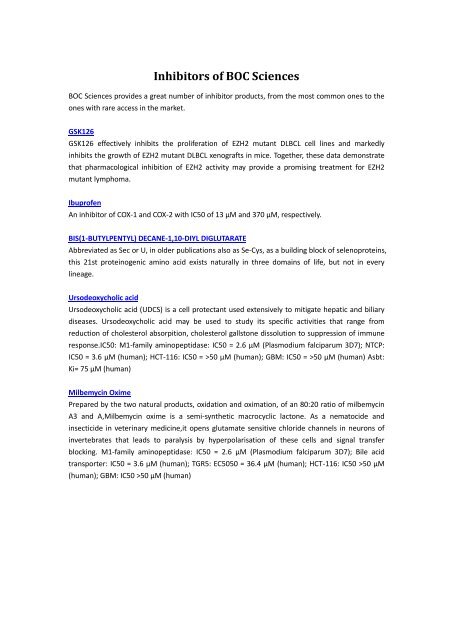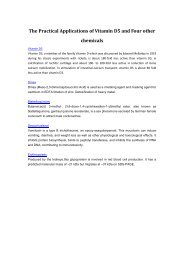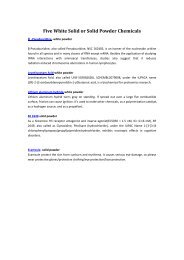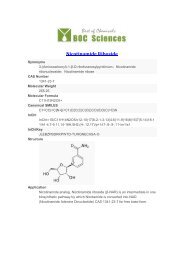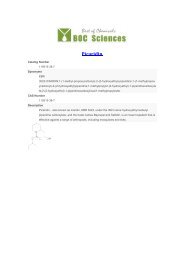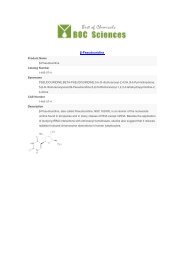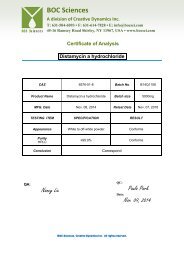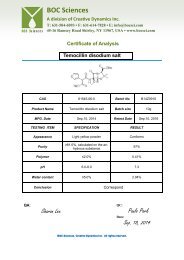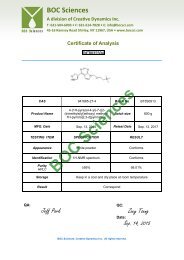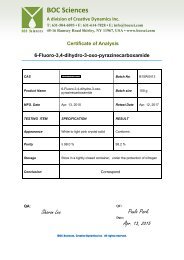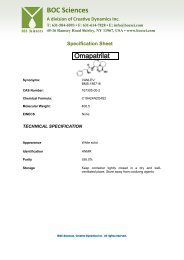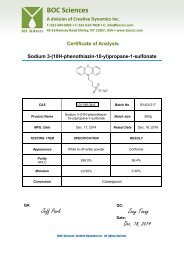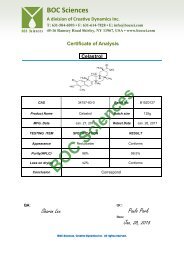Inhibitors of BOC Sciences
BOC Sciences provides a great number of inhibitor products, from the most common ones to the ones that with rare access in the market.
BOC Sciences provides a great number of inhibitor products, from the most common ones to the ones that with rare access in the market.
Create successful ePaper yourself
Turn your PDF publications into a flip-book with our unique Google optimized e-Paper software.
<strong>Inhibitors</strong> <strong>of</strong> <strong>BOC</strong> <strong>Sciences</strong><br />
<strong>BOC</strong> <strong>Sciences</strong> provides a great number <strong>of</strong> inhibitor products, from the most common ones to the<br />
ones with rare access in the market.<br />
GSK126<br />
GSK126 effectively inhibits the proliferation <strong>of</strong> EZH2 mutant DLBCL cell lines and markedly<br />
inhibits the growth <strong>of</strong> EZH2 mutant DLBCL xenografts in mice. Together, these data demonstrate<br />
that pharmacological inhibition <strong>of</strong> EZH2 activity may provide a promising treatment for EZH2<br />
mutant lymphoma.<br />
Ibupr<strong>of</strong>en<br />
An inhibitor <strong>of</strong> COX-1 and COX-2 with IC50 <strong>of</strong> 13 μM and 370 μM, respectively.<br />
BIS(1-BUTYLPENTYL) DECANE-1,10-DIYL DIGLUTARATE<br />
Abbreviated as Sec or U, in older publications also as Se-Cys, as a building block <strong>of</strong> selenoproteins,<br />
this 21st proteinogenic amino acid exists naturally in three domains <strong>of</strong> life, but not in every<br />
lineage.<br />
Ursodeoxycholic acid<br />
Ursodeoxycholic acid (UDCS) is a cell protectant used extensively to mitigate hepatic and biliary<br />
diseases. Ursodeoxycholic acid may be used to study its specific activities that range from<br />
reduction <strong>of</strong> cholesterol absorpition, cholesterol gallstone dissolution to suppression <strong>of</strong> immune<br />
response.IC50: M1-family aminopeptidase: IC50 = 2.6 µM (Plasmodium falciparum 3D7); NTCP:<br />
IC50 = 3.6 µM (human); HCT-116: IC50 = >50 µM (human); GBM: IC50 = >50 µM (human) Asbt:<br />
Ki= 75 µM (human)<br />
Milbemycin Oxime<br />
Prepared by the two natural products, oxidation and oximation, <strong>of</strong> an 80:20 ratio <strong>of</strong> milbemycin<br />
A3 and A,Milbemycin oxime is a semi-synthetic macrocyclic lactone. As a nematocide and<br />
insecticide in veterinary medicine,it opens glutamate sensitive chloride channels in neurons <strong>of</strong><br />
invertebrates that leads to paralysis by hyperpolarisation <strong>of</strong> these cells and signal transfer<br />
blocking. M1-family aminopeptidase: IC50 = 2.6 µM (Plasmodium falciparum 3D7); Bile acid<br />
transporter: IC50 = 3.6 µM (human); TGR5: EC5050 = 36.4 µM (human); HCT-116: IC50 >50 µM<br />
(human); GBM: IC50 >50 µM (human)


